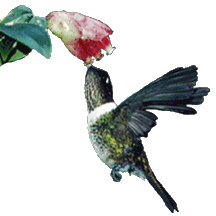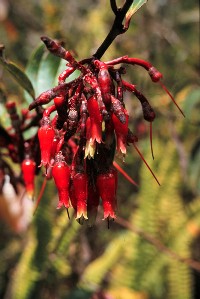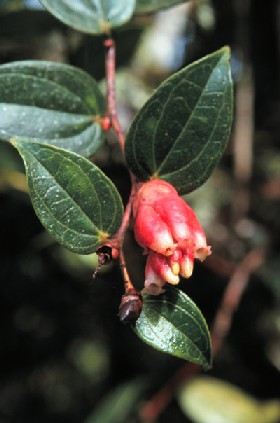 |
| INTRODUCTION The hummingbirds forage pattern and its relationship with the volume and concentration of floral nectar has been studied in several occasions, most of these researches have been developed at locations under 2000 msnm, where flowers produce an average of nectar concentration of 20 % with a volume high enough to benefit hummingbirds living in water limited areas. Heliangelus spencei (TROCHILIDAE) is an endemic bird from M�rida-Venezuela that lives in the cloud forest and �p�ramo� (2000-3600 m). Cavendishia bracteata and C. pubescens (ERICACEAE) are widely distributed in Central and Suth America, and its flowers are conspicuosly ornithofilous. In the cloud forest of M�rida the relative humidity goes from 80 to 100%, wich means a low evaporating demand of the ambience and raises the following question: Does H. spencei improve its forage activity visiting C. bracteata and C. pubescens flowers in the moments of the day when the nectar concentration is higher or does its strategy consists of visiting the flowers when these offer a higher nectar volume?. In order to answer this question we proposed the following objectives: 1.- Register the nectar volume and concentration variation produced by C.bracteata and C. pubescens during the day. 2.- Monitor the forage daily activity of H. spencei on C. bracteata and C. pubescens. MATERIALES AND METHODS Once C.bracteata and C. pubescens individuals were selected, H.spencies forage activity was observed (number of visits (NV), length of visit, territoriality). Additionally some filming was made in order to measure handling time (TM) using and adapted version of some methods used formerly under laboratory conditions. Before measuring nectar concentration and volumen, all of the flowers (146 C.bracteata and 123 C. pubescens) were isolated with polyester net bags (Pore = 0.1 mm) preventing any nectarivorous access. Nectar samples were taken every two hours (06:00 � 18:00 hrs) with capillary tubes of 20 ?l, measuring column length inmediately and then calculating the total nectar volume (VN) extrated. Nectar concentration (NC) was measured with a laboratory refractometer (ATAGO, range = 0-32 %, 0.5% precision, temperature compensated). VN,CN,NV and TM values were displayed in a graphic vs time in order to analyze such variables during the day. RESULTS AND DISCUSSION Data indicates that H. spencei is very active during first and last hours of the day (06:00 � 10:00 and 16:00 � 18:00 h respectively) decreasing his activity notably close to noontime, when VN values in both Cavendishia got lower. A positive correlation was found (r = 0.9) between VN and NV values of H. spencei and flowers of both species, the same way the correlation between TM and VN is also positive (r = 0.8). Contradicting some results obtained in the laboratory, we can also find a negative correlation between CN and TM (- 0.6). These results suggest that H. spencei activity as in nectar production, both Cavendishias could be responding to ambience evaporating demmand, in this case bird and plant have coadapted metabolic and physiologically to improve their energy flow. CONCLUTIONS AND RECOMENDATIONS Heliangelus spencei improves its forage activity, investing a greater effort when C. bracteata and C. pubescens produce more nectar, such strategy doesn�t differ much from the one used by the hummingbirds from low lands, and could be more similar in higher zones like in �paramos�. Lab tests indicate that TM depends on CN, this research has found that in natural conditions, TM depends on VN and not on CN, this discordance is due to the artificial nectar concentrations used for such tests, wich differ greatly from the values generally found in nature. We have focused on evaluating the nectar production in two important Ericaceas in the H. spencei diet, omitting some factors that could be related to such production like temperature and sun exposure, nectar and polen consumption from some small arthropods (acarus and coleopterus) seen frequently on flowers from both plant species, hummingbirds role as transport vectors of these arthropods and the existence of phylogenetic parallelisms among acarus, vectors and plants. |
 |
| FORANGING STRATEGY OF Heliangelus spencei (TROCHILIDAE), ON TWO ERICACEAS, IN A VENEZUELAN ANDES CLOUD FOREST Luis J. Cornejo U., Carlos Rengifo & Pascual Soriano |
| Helinagelus spencei viisiting a Cavendishia bracteata flower |
 |
| Cavendishia pubescens |
 |
| Cavendishia bracteata |